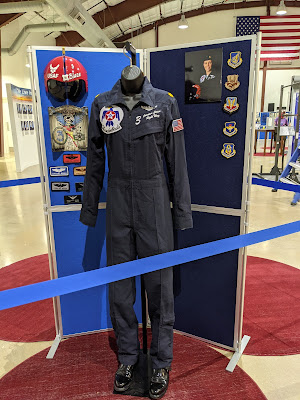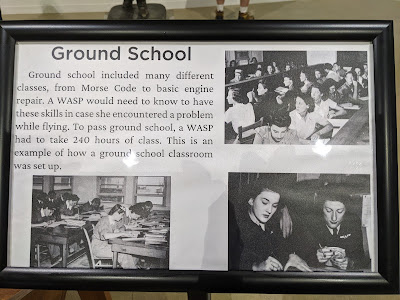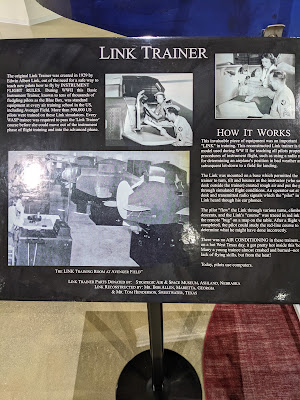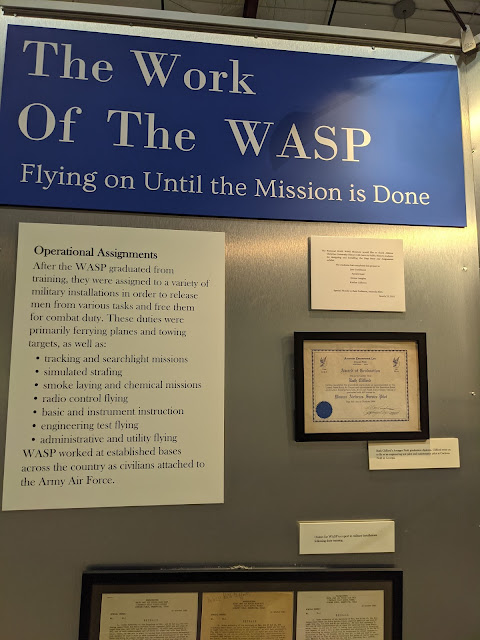On Friday morning, we met at the Rally Room and set out for Sweetwater about 45 minutes away. Our goal was the National WASP WWII Museum.
The museum takes up two hangers.
Women
Airforce Service Pilots (WASP) originated with a pair of very ambitious and skilled
female flyers.
Nancy Harkness Love was the youngest American woman to earn
her private pilot’s license prior to World Ward II. She lobbied for creation of
a program using female pilots to ferry warplanes from factories to air bases. Jackie Cochran, considered one of the most accomplished
pilots of her time, demonstrated the capability of the idea by flying a
lend-lease bomber to England and organizing a group of female pilots for war
transport service as part of the British Air Transport Auxiliary. American
military leaders became increasingly open to Love’s and Cochran’s ideas by 1942
when war reduced the available number of qualified male pilots.
Love organized the Women’s Auxiliary Ferrying Squadron
(WAFS) in September 1942 when two dozen of the best female civilian pilots reported
to New Castle Army Air Base in Delaware for transport training. Cochran
persuaded Army Air Forces commander General “Hap” Arnold to activate the
Women’s Flying Training Detachment (WFTD) two months later at Howard Hughes
Airport in Houston.
In August 1943, the two programs were merged as WASP with
Cochran as the Director and Love as executive on the Air Transport Command
Ferrying Division staff.
More than 25,000 women applied for pilot training, 1830
were accepted, and 1073 graduated. Candidates had to be between 21 and 35,
already have a commercial pilot’s license, and have the physical endurance to
complete the military training regimen that was part of the selection process.
Ground school took 240 hours and required them to learn
Morse code and basic engine repair.
And then there was the flight training on military aircraft.
After graduation they served as flight training
instructors, glider tow pilots, towing targets for air-to-air and anti-aircraft
live ammunition gunnery practice, engineering test flying, ferrying aircraft
and other duties. They flew more than 60 million miles and every type of
aircraft in the army air forces. The 38 women who were killed while serving
were not entitled to burial services or survivor benefits because they were
considered part of the civil service.
The WASP program was disbanded without ceremony in December
1944 as the war wound down. The final class was allowed to graduate, served 2 ½
weeks, and then were let go to find their own way home with the rest of the
women. WASP program records were sealed. The women rarely talked about it as no one
believed them. In 1977, the Air Force announced that they were accepting women
to the academy who would become the first female pilots.
Surviving WASP pilots stood up and stated this wasn’t true
as they were the first female pilots.
Senator Barry Goldwater who also served
as a ferry pilot during WWII, led the efforts to recognize the WASP. President
Jimmy Carter signed the bill militarizing the WASP and recognizing WASP pilots
as veterans. In 2009, President Barack Obama signed a bill giving the
Congressional Gold Medal to the WASP. More than 200 WASP attended a ceremony to
finally receive their decorations.



















No comments:
Post a Comment
Thanks for commenting.